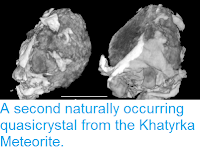Micrometeorites are particles of extra-terrestrial material less than 2 mm across. These have been collected from a number of environments, including Antarctic blue ice and snow, deep sea sediments and even rooftops, and are the most abundant form of meteorite material available to scientists. Scoriaceous micrometeorites are micrometeorites dominated by micron-sized equant iron-rich olivine crystals within a glassy mesostasis, which is thought to be indicative of having undergone caused by superheating from friction with the
Earth's atmosphere due to the orbital momentum of the asteroid, which is greater than that caused by simply
falling.
In a paper published in the journal Geology on 17 August 2017, Matthew Genge and Martin Suttle of the Impact and Astromaterials Research Centre at Imperial College London, and the Earth Sciences Department at The Natural History Museum, and Matthias Van Ginneken of Earth System Science at the Vrije Universiteit Brussel, present the results of a study in which they examined scoriaceous micrometeorites in order to attempt to determine their origin and the stresses that they been subjected to.
Scoriaceous micrometeorites contain clusters of clusters of forsterite and enstatite crystals, which Genge et al. believe to have been formed by the fragmentation of larger crystals due to superheating, as other micrometeorites lack these, suggesting that the the original crystals cannot be fractured in this way by shockwaves passing through the minerals as the parent bodies fragment in the atmosphere, impact the ground, or undergo some process in space unrelated to their eventual decent to Earth. They suggest that the most likely cause of such fragmentation is thermal stress, as different minerals within the micrometeorite expand at different rates when heated.
Backscattered electron images of micrometeorites. (A) Highly vesicular scoriaceous micrometeorite containing a cluster of forsterite (FO) relicts and eskoliate (CR). (B) A scoriaceous micrometeorite with a well developed external magnetite rim and clusters of forsterite (FO). Small triangular shards of forsterite are present close to larger crystals. This particle is similar to a micro-porphyritic olivine cosmic spherule. An expanded inset shows a cluster of small enstatite crystals. (C) A scoriaceous micrometeorite containing abundant vesicles and a magnetite rim. Two areas of relicts occur, one enstatite (FE) exhibits abundant fractures partially infilled with mesostasis (MV). (D) A scoriaceous micrometeorite containing two clusters of forsterites (FO) consisting of numerous individual crystals. (E) An unmelted finegrained micrometeorite with an external igneous rim (IR) surrounding an unmelted core (UC). A forsterite relict (FO) is present that truncates the igneous rim ((f) shows expanded view) and contains numerous fractures partially infilled with melt and is surrounded by a magnetite rim (MR). Fracturing within the crystal is most abundant in the part closest to the surface of the particle. Scale bars are 50 μm, except in (f) where it is 5 μm. Genge et al. (2017).
Genge et al. were able to construct a model of the rate at which forsterite expands due to heating, and from this determine the temperature to which these minerals had been raised, and the difference in temperature across the mineral grain; suggesting that in some cases this temperature difference may be as much as 4000 K per μm, resulting in a high degree of shear stress, caused by different parts of the crystal expanding at different rates, and causing the crystal to shatter.
Such a high temperature difference within a micrometeorite requires some explanation, as most minerals conduct heat fairly well. Genge et al. theorise that this may have been caused by the parent bodies having been comprises of at least 5% phyllosilicates (sheet minerals such as micas, chlorite, serpentine, talc, and the clays), which conduct heat poorly, and which would have been destroyed by the very high temperatures implied.
This in turn suggests that the original material from which these micrometeorites were derived was similar in composition to that of a CI1 or CM2 carbonaceous chondrite, meteorites with a high composition of phyllosilicates. CM2 chondrites have previously been shown to lose phyllosilicates due to dehydration (the loss of hydrogen and oxygen from the mineral as water) at high presures, suggesting that scoriaceous micrometeorites may be formed specifically from the fragmentation of such chondrites, rather than being the products of any meteorite raised to the correct temperature.
About half of all micrometeorite-sized particles entering the Earth's atmosphere are thought to be derived from members of the Veritas Asteroid Family (a group of asteroids in the Outer Main Belt thought to have formed about 8.5 million years ago by the break-up of a large parent-body), with much of the remaining material derived from the Koronis Family Asteroids (a group of asteroids in the Central Main Belt thought to have formed by the collision of two large bodies about two billion years ago), and a small contribution from the Themis Family (a group of asteroids in the Outer Main Belt thought to be the main source of carbonaceous chondrites).
The Koronis Family Asteroids is thought to produce only ordinary chondritic material, while both the Veritas and Themis families are thought to produce carbonaceous chondritic material. Genge et al. suggest that the likely carbonaceous origin of scoriaceous micrometeorites implies that these are most likely to have originated from the Veritas and Themis asteroid groups.
See also...
Follow Sciency Thoughts on Facebook.







